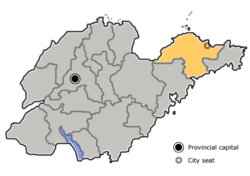Yantai
|
Yantai 烟台市 |
|
|---|---|
| Prefecture-level city | |

Yantai Skyline
|
|
 Location of Yantai City Jurisdiction in Shandong |
|
| Location in China | |
| Coordinates: 37°32′6″N 121°23′21″E / 37.53500°N 121.38917°ECoordinates: 37°32′6″N 121°23′21″E / 37.53500°N 121.38917°E | |
| Country | China |
| Province | Shandong |
| County-level divisions | 12 |
| Townships-level divisions | 148 |
| Municipal seat | Laishan District |
| Government | |
| • CPC Secretary | Zhang Jiangting 张江汀 |
| • Mayor | Meng Fanli 孟凡利 |
| Area | |
| • Prefecture-level city | 13,739.9 km2 (5,305.0 sq mi) |
| Population (2010) | |
| • Prefecture-level city | 6,968,202 |
| • Density | 510/km2 (1,300/sq mi) |
| • Urban | 2,227,733 |
| • Metro | 2,227,733 |
| Time zone | China Standard (UTC+8) |
| Postal code | 264000-265800 |
| Area code(s) | 535 |
| GDP | ¥435.8 billion (2010) |
| GDP per capita | ¥62,541 (2010) |
| License Plate | 鲁F & 鲁Y |
| Website | www |
| Yantai | |||||||||||

"Yantai" in Chinese
|
|||||||||||
| Simplified Chinese | |||||||||||
|---|---|---|---|---|---|---|---|---|---|---|---|
| Traditional Chinese | |||||||||||
| Literal meaning | "Smoke Tower" | ||||||||||
|
|||||||||||
| Transcriptions | |
|---|---|
| Standard Mandarin | |
| Hanyu Pinyin | Yāntái |
| Wade–Giles | Yan1-t‘ai2 |
| IPA | [jɛ́ntʰǎi] |
| Former names | |||||||

A Qing-era postage stamp from Zhifu ("Chefoo")
|
|||||||
| Zhifu | |||||||
|---|---|---|---|---|---|---|---|
| Chinese | |||||||
| Postal | Chefoo | ||||||
|
|||||||
| Transcriptions | |
|---|---|
| Standard Mandarin | |
| Hanyu Pinyin | Zhīfú |
Yantai, formerly known as Zhifu or Chefoo, is a prefecture-level city on the Bohai Strait in northeastern Shandong Province, China. Lying on the southern coast of the Korea Bay, Yantai borders Qingdao on the southwest and Weihai on the east. It is the largest fishing seaport in Shandong. Its population was 6,968,202 during the 2010 census, of whom 2,227,733 lived in the built-up area made up of the 4 urban districts of Zhifu, Muping, Fushan, and Laishan.
The name Yantai (lit. "Smoke Tower") derives from the watchtowers constructed on Mount Qi in 1398 under the reign of the Hongwu Emperor of the Ming dynasty. The towers were used to light signal fires and send smoke signals, called langyan from their supposed use of wolf dung for fuel. At the time, the area was troubled by the "Dwarf Pirates" (Wokou), initially raiders from the warring states in Japan but later principally disaffected Chinese. It was also formerly romanized as Yen-tai.
...
Wikipedia

